Product Reviews: Lucky Craft
It's
fair to say Lucky Craft manufactures some of the best
hard plastic baits in the world. Lucky Craft manufactures their
baits in a small town near a pure flowing river in Japan. Their
is a big emphasis on lure research and development and among
members of the Lucky Craft company, they feel a big
responsibility to produce lures worthy of both the angler and the
fish of which he dreams. Here are some tips on how to fish these
Lucky Craft dreams.
Lucky Craft began to appear on the North American
market about five or six years ago. The baker's dozen listed
below are the first Lucky Craft lures that were available in the
States. These originals still rank among Lucky Craft's most
reliable fish-catchers:
-
Sammy 85, 100, and 115 topwater walking baits
-
G-Splash 65 topwater popper
-
Pointer 78 and 100 suspending jerkbaits
-
Bevy Shad 75 a wider-bodied, deeper suspending
jerkbait
-
StaySee 90, a longer-lipped, even deeper
suspending jerkbait
-
Flash Minnow 110 a short-lipped shallow
suspending jerkbait
-
CB200 and CB350 Moonsault suspending diving
crankbaits
-
LV100 and LV500 lipless rattling crankbaits
If you had to limit your Lucky Craft selection to
a core set of lures to work with, you really can't go wrong by
sticking with the originals listed above.
However, Lucky Craft hardly stopped there. In the
past five years, Lucky Craft has rolled out additional topwaters,
jerkbaits and crankbaits for North American freshwater bass
fishing.
Today there are 70 models of injection-molded
hard plastic baits that Lucky Craft offers you.
What's a fellow to do? How's someone to know
which one to use when? With the premium price commanded by Lucky
Craft baits, how can the average guy afford to try all these
great baits? Will his wife let him? Will the kids still be able
to go to college?
Without further ado, here is the biggest helping of useful
how-to info in print on Lucky Craft lures in North America. It
doesn't cover all 70 models, but it does cover over 35 of the
best Lucky Crafts available (plus a few discontinued models you
really should try to get your hands on). Please enjoy!
Color Considerations:
These are the staple Lucky Craft colors I rely on day in and day
out. You can get these four colors in practically all Lucky Craft
hardbait models:
- Chartreuse Shad (#250). If I had to pick only one
Lucky Craft color to use, it would be this. An opaque (solid)
color with smoky blue/gray back, smoky pearl belly, and pale
chartreuse lateral line. It is a great all-around producer under
a wide variety of water color and conditions.
- Pearl Ayu (#268). Another productive opaque color that
works under most conditions. A watermelon green back with shiny
pearl sides that emit a bright white flash.
- Ghost Minnow (#238). Greenish translucent see-through
color that is ideal for clear or stained water. Has pale blue and
pink translucence on sides and pale white underbelly.
- Ghost Blue Shad (#237). Another productive transparent
color, with a faint blue back similar to shad at times.
A high degree of my confidence and catches also come on these
two color patterns. However, they are only available in a few
limited Lucky Craft models:
- Misty Shad (#284), an opaque color
- Opaque Golden Shiner (#239) plus transparent Aurora
Ghost Golden Shiner (#057)
The colors listed above account for many of my Lucky Craft
catches. |
| Lucky Craft Sammy
115 and Sammy 100 Topwalkers |
| Sammy 115. 4-1/2". 5/8 oz. Sammy
100. 4". 1/2 oz. |
 The
Sammy 115 (bottom in photo) is my favorite size. It casts
extremely well. When replaced with #2 hooks, the Sammy 115
becomes very special to fish in deeper calm water using a slow,
gentle walk-the-dog action that makes the nose barely twitch
without splashing. The
Sammy 115 (bottom in photo) is my favorite size. It casts
extremely well. When replaced with #2 hooks, the Sammy 115
becomes very special to fish in deeper calm water using a slow,
gentle walk-the-dog action that makes the nose barely twitch
without splashing.
I downsize to the Sammy 100 (top in photo) in shallower water,
or whenever the fish show no interest in the 115, that's when
I'll go to the Sammy 100. I give you more precise info on how I
use these two in an article, Sammy
- The Walking Fish.
There are two smaller (65 and 85) and one larger
(128) version of Sammy also. Many anglers experience great
success with these smaller and larger Sammy sizes as well. |
| Lucky Craft
Gunfish 95 Topwalker |
| Gunfish 95. 4". 3/8 oz. |
 The
Gunfish is unique in shape and different in action than other
topwalkers like the Sammy. The Gunfish has a more spitty, slashy,
frantic action. It skates its body side to side rather than roll
or waddle like other topwalkers. Many anglers tend to work the
Gunfish faster and more frantically than they would a Sammy. The
Gunfish is unique in shape and different in action than other
topwalkers like the Sammy. The Gunfish has a more spitty, slashy,
frantic action. It skates its body side to side rather than roll
or waddle like other topwalkers. Many anglers tend to work the
Gunfish faster and more frantically than they would a Sammy.
The Gunfish 95 was the first model available. The
larger Gunfish 115 (5/8 oz) was introduced later, but quickly
became favored by many anglers, due to the 115's larger size. In
fact, if you are after big bass or just need a solitary kicker,
the Gunfish 115, the Sammy 128 and Sammy 115 are the three
"large" Lucky Craft topwaters to use to tempt
above-average bass. |
| Lucky Craft
G-Splash 65 Popper |
| G-Splash 95. 2 1/2". 1/4 oz. |
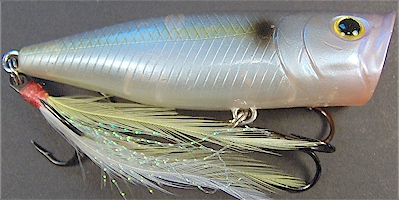 The
G-Splash is G-ood! In calm flat water, the G-Splash throws a big
splash ahead of itself, sounding the dinner bell for active,
aggressive fish to come running long distances out of cover or up
from the depths to greedily smack at the G-Splash. In choppy
water, part of the big splash made by the G-Splash pushes
underneath the choppy surface, creating wavy rings like a boil
circling around the G-Splash. It's a real attention-getter. The
G-Splash is G-ood! In calm flat water, the G-Splash throws a big
splash ahead of itself, sounding the dinner bell for active,
aggressive fish to come running long distances out of cover or up
from the depths to greedily smack at the G-Splash. In choppy
water, part of the big splash made by the G-Splash pushes
underneath the choppy surface, creating wavy rings like a boil
circling around the G-Splash. It's a real attention-getter.
Using a very fast, choppy rod tip movement of
only a few inches, the G-Splash will walk side-to-side across the
surface more like a Sammy or Spook style of action. You've got to
get the tip vibrating back and forth very quickly to do this.
It's a little tiring to do this all day, but I like the action it
produces - and apparently so do a lot of fish I have caught with
this tactic! I give you more precise info on how I use it in an
article, G-Splash - The
Newest Pop on Top.
The G-Splash is designed differently than most
other poppers. The most obvious difference is that it has a
square bottom as opposed to smooth round body, the surface area
inside the concavity is greater and deeper on the G-Splash, and
the ridge where the concavity meets the body is raised so the
"lip" protrudes. Interesting departures from the norm.
There is also a relatively newer, larger version.
The G-Splash 80 is 3" and 3/8 oz. This is a trend in bass
fishing today towards larger poppers, and they do tend to result
in larger bass. |
| Lucky Craft
Splash-Tail 90 Propbait |
| Splash-Tail. 3-5/8". 1/2 oz. |
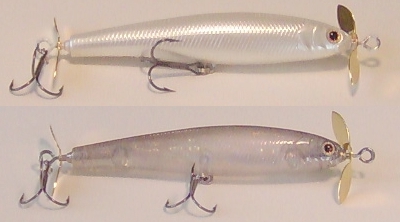 This
propbait has precision-made fore and aft propellers, each affixed
to a metal sleeve that helps the prop turn more easily and
precisely. Most other propbaits do not have such a sleeve. Mostly
you see just loose prop. This
propbait has precision-made fore and aft propellers, each affixed
to a metal sleeve that helps the prop turn more easily and
precisely. Most other propbaits do not have such a sleeve. Mostly
you see just loose prop.
Propbaits are relatively unused, bass don't get to see them
much. That's why I use them a lot. You can go down a hard-hit
bank or through a community hole where bass have wizened up to
being pelted by more popular lures. Tie something on they've not
yet seen. On some days it seems almost every jaded bass there
will take a swipe at a novel lure type like a propbait that they
have not seen yet. |
| Lucky Craft
Jerkbaits |
 Don't
see a jerkbait you like in the photo at right? Don't worry. Lucky
Craft offers sixteen more jerkbait models in addition to the
eight shown at right. Don't
see a jerkbait you like in the photo at right? Don't worry. Lucky
Craft offers sixteen more jerkbait models in addition to the
eight shown at right.
These are the eight, however, that I use most often. From top
down:
- Pointer 100DD
- Pointer 100
- Staysee 90
- Slender Pointer 97
- Flash Minnow 95
- Bevy Shad 75
- Pointer 78DD
- Pointer 78
For more info on how to use jerkbaits in general, and Lucky
Craft's Pointer, Bevy Shad and Staysee in particular, check out
my article, Jerkbaits
for Late Fall Flats. Also check the interview I did on Ripbaits
as Taught by Gary Dobyns, who's also know as Mister
Rippin'. And when you're done with those articles, don't
forget to get A
Little Extra Jerkbait Gravy.
|
|
| Lucky Craft
Pointer 78 Jerkbait |
| Pointer 78. 3" (excluding lip). 3/8 oz. |
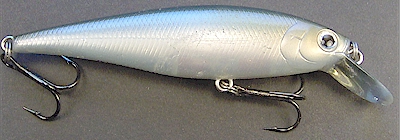 You
probably don't need me to tell you about the Pointer 78. Of all
Lucky Craft lures, the Pointer 78 and the Sammy topwater series
are most famous. More has been written about the Pointer and
Sammy than all other Lucky Crafts combined. You
probably don't need me to tell you about the Pointer 78. Of all
Lucky Craft lures, the Pointer 78 and the Sammy topwater series
are most famous. More has been written about the Pointer and
Sammy than all other Lucky Crafts combined.
I must say this, of all Lucky Craft lures I have fished, the
Pointer 78 has the most life-like action. Something in the design
of the Pointer 78 gives it an occasional irregular action which
is very special because it approximates the mindless dalliance of
a real bait better than the mechanical metronome of most other
baits.
Truly a treasure, the Pointer 78 is absolutely perfect for
subsurface twitching, jerking or ripping tactics all season long!
It works from subsurface down a few feet. |
| Lucky Craft
Pointer 78DD Jerkbait |
| Pointer 78DD. 3" (excluding lip). 1/3 oz. |
 Nearly
as good as the original Pointer 78 - and deadly, deadly, deadly
in the slightly deeper 4 to 7 foot range that the Pointer 78DD is
designed to plumb. Nearly
as good as the original Pointer 78 - and deadly, deadly, deadly
in the slightly deeper 4 to 7 foot range that the Pointer 78DD is
designed to plumb.
|
| Lucky Craft Bevy
Shad 75 Jerkbait |
| Bevy Shad. 3" (excluding lip). 3/8 oz. |
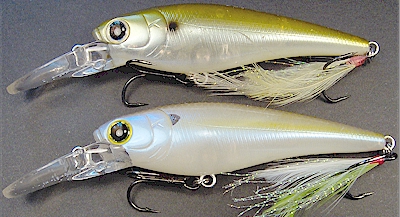 As
famous as the Pointer has become, you hardly hear a peep about
the Bevy Shad. Despite its anonymity, it is a great fish-catcher. As
famous as the Pointer has become, you hardly hear a peep about
the Bevy Shad. Despite its anonymity, it is a great fish-catcher.
The Bevy Shad has a more crankbait-shaped bill and a more
crankbait-shaped body than most other slim minnow jerkbaits. Is
the Bevy Shad a jerkbait? A crankbait? Two baits in one? Does how
a lure looks define it, or does the suspension system inside it
define it? Or does how you fish it (crank it or jerk it) make
something a crankbait or a jerkbait? Disturbing as such questions
may be, should we really care? Bottom line, the Bevy Shad is a
great fish-catcher, but little has ever been communicated about
it, and relatively few people fish it because they never heard of
it. Everyone has heard of the Pointer. Far fewer have ever heard
a word about the Bevy Shad.
The Bevy Shad has a fast, tight wriggle like a swimming shad.
It darts widely like a disoriented shad when paused and twitched.
It works deeper than most other jerkbaits. It's effective working
depth is about 8 feet down on 10 lb. line. When it comes to 8
feet deep, there are hardly any jerkbaits that get down there.
The Bevy Shad is internally balanced to swim with a nose-down
angle until it reaches its maximum depth where it will level off
and swim on a horizontal plane. Its nose-down nature and
arrow-shaped bill is good for bouncing the hooks away to deter
snags in cover or on bottom...then suspend and twitch it after it
bounces off bottom or cover. When suspended, it dips its
nose down into a feeding posture which often infuriates following
bass to strike. In shallower water, the Bevy Shad sinks slowly as
opposed to suspending as in deeper depths. This nose-down dip and
settling towards bottom in a feeding posture is awesome over
shallow spring spawning sites.
The Golden Shiner color (top in photo) has always been
a favorite and most productive Lucky Craft hue for me.
Unfortunately, Golden Shiner is not an option in many Lucky Craft
models. Good news is the Bevy Shad is one of the few that comes
in Golden Shiner. This is the Bevy Shad color I use ninety
percent of the time.
I often fish the Bevy Shads with feather tails. I have
experienced high catch rates using feathers on Bevy Shads. I
switch out the belly hook for the same size Gamakatsu EWG. I
switch out the tail for one size smaller Owner feather treble.
I'm normally not one to downsize hooks, but the extra water drag
of the feathers requires it in this case. Neither am I one to
indiscriminately hang feather tails on all my hardbaits. In the
Bevy Shad's case, however, this feather tail seems to enhance the
lifelike allure of the Bevy Shad. Add a long thin feather tail
and watch as the feathers makes the Bevy Shad come alive! It's
been bevy, bevy good to me! |
| Lucky Craft
Staysee 90 Jerkbait |
| StaySee 90. 3-1/2" (excluding lip). 1/3 oz. |
 Of
all Lucky Craft lures I have used, the StaySee 90 has one of the
most life-like actions. When the jerkbait bite is on, I am
basically going to cover the water column by using the Pointer 78
for subsurface action down to a few feet deep, the Bevy Shad 75
or the Pointer 78DD to get down to about the six foot range, and
the StaySee 90 to dredge even deeper. Where bigger bass abound, I
may go to bigger jerkbaits, but on most waters with average size
bass, the Pointer 78, Pointer 78DD, Bevy Shad 75, and StaySee 90
progressively cover the water column for me from a few feet to
about ten feet down. Of
all Lucky Craft lures I have used, the StaySee 90 has one of the
most life-like actions. When the jerkbait bite is on, I am
basically going to cover the water column by using the Pointer 78
for subsurface action down to a few feet deep, the Bevy Shad 75
or the Pointer 78DD to get down to about the six foot range, and
the StaySee 90 to dredge even deeper. Where bigger bass abound, I
may go to bigger jerkbaits, but on most waters with average size
bass, the Pointer 78, Pointer 78DD, Bevy Shad 75, and StaySee 90
progressively cover the water column for me from a few feet to
about ten feet down.
Adding the next size bigger trebles to this lure
beefs the StaySee up tremendously. A great, great jerkbait that
has not gotten the recognition it deserves. |
| Lucky Craft
Pointer 100 Jerkbait |
| Pointer 100. Suspending. 4" (excluding lip). 5/8
oz. |
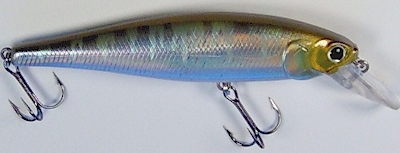 Compared
to the Pointer 78, the Pointer 100 is a bigger, bulkier
suspending jerkbait. I tend to use it on a heavier rod and at
least 12 lb test, for targeting better than average bass - or for
snubbing up on and controlling fish close to bad cover. The
heavier gear lets me wrestle a stuck lure or a wild hog away from
snags. I can pull just a little harder with the Pointer 100. It's
a solidly-built jerkbait. I estimate the Pointer 100 runs 4 to 5
feet casting on 12 lb line. Compared
to the Pointer 78, the Pointer 100 is a bigger, bulkier
suspending jerkbait. I tend to use it on a heavier rod and at
least 12 lb test, for targeting better than average bass - or for
snubbing up on and controlling fish close to bad cover. The
heavier gear lets me wrestle a stuck lure or a wild hog away from
snags. I can pull just a little harder with the Pointer 100. It's
a solidly-built jerkbait. I estimate the Pointer 100 runs 4 to 5
feet casting on 12 lb line.
It is suspending, meaning it attains a neutral buoyancy at a
specific atmospheric pressure and water temperature. But when not
near those precise conditions, a suspending jerkbait rises or
sinks slowly due to higher or lower pressure and/or temps than
its neutral equilibrium point.
This color shown here, Misty Shad is only made in a few
Lucky Craft models. However, it is one of my favorite Lucky Craft
colors. |
| Lucky Craft
Pointer 100DD Jerkbait |
| Pointer 100DD. 4" (excluding lip). 5/8 oz. |
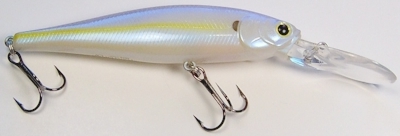 Compared
to say the Pointer 78DD or Staysee 90, the Pointer 100DD is a
bigger, bulkier suspending jerkbait. I tend to use it on a
heavier rod and at least 12 lb test, for targeting better than
average bass - or for snubbing up on and controlling fish close
to bad cover. The heavier gear lets me wrestle either a
stuck lure or a wild hog away from snags. I can pull just a
little harder with the Pointer 100 DD. It's a solidly-built
jerkbait. Compared
to say the Pointer 78DD or Staysee 90, the Pointer 100DD is a
bigger, bulkier suspending jerkbait. I tend to use it on a
heavier rod and at least 12 lb test, for targeting better than
average bass - or for snubbing up on and controlling fish close
to bad cover. The heavier gear lets me wrestle either a
stuck lure or a wild hog away from snags. I can pull just a
little harder with the Pointer 100 DD. It's a solidly-built
jerkbait.
It is suspending, meaning it attains a neutral buoyancy at a
specific atmospheric pressure and water temperature. But when not
near those precise conditions, a suspending jerkbait rises or
sinks slowly due to higher or lower pressure and/or temps than
its neutral equilibrium point.
I estimate the Pointer 100 DD runs 5 to 7 feet casting on 12
lb line. It can get down eight feet by burning it back in at a
blurring speed. Burning the Pointer 100 DD works best when
you jerk and give slack to let it stand still every twenty feet
during the retrieve, which is when most strikes occur. Fish will
race along behind it while you burn it as fast as you can for
twenty feet, and tend to react by striking when it darts and
suddenly stands still. |
| Lucky Craft Flash
Minnow TR95 Jerkbait |
| Flash Minnow TR95. 3-3/4" (excluding lip). 5/16
oz. Lucky Craft USA has discontinued
this lure. |
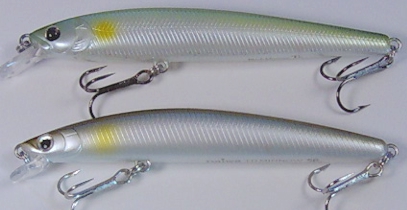 This
is a light jerkbait. If you need something sweet for 6-8 lb test,
it's ideal for that. It's a shallow runner and doesn't swim more
than a few feet below the surface. This
is a light jerkbait. If you need something sweet for 6-8 lb test,
it's ideal for that. It's a shallow runner and doesn't swim more
than a few feet below the surface.
As shown in the photo, there's much similarity between the
Lucky Craft Flash Minnow TR95 (top) versus Daiwa's TD Minnow
(bottom).
Originally, before Lucky Craft began to pursue a market share
in North America, Daiwa's TD Minnow had already established
itself as a reputable high-end jerkbait - and still to this day,
the TD Minnow remains famed for good catches. Although Lucky
Craft's Flash Minnow TR95 compares favorably, it is being
discontinued in North America. Despite that, the Lucky Craft TR95
is a good fish-catcher. Particularly on light tackle, it casts
well and fishes superbly. If you've ever done well with the Daiwa
TD Minnow, I'd suggest the Lucky Craft Flash Minnow TR95 is
another worthy one you may want to try. Before it disappears
forever, now may be the time to add this fine light line jerkbait
to your tackle box. |
| Lucky Craft Flash
Minnow 95MR Jerkbait |
| Flash Minnow 95MR. 3-3/4" (excluding lip). 3/8
oz. |
 The
Flash Minnow 95MR is solidly built. It is a smallish lure but has
the bigger hooks and chutzpah to handle decent fish. The
Flash Minnow 95MR is solidly built. It is a smallish lure but has
the bigger hooks and chutzpah to handle decent fish.
This bait casts like a rifle shot due to some heavy ballast in
the back of its tail. Not only does this tail weight give it
casting distance, it gives it an up and down seesaw effect. When
you twitch or reel it, the diving lip forces the nose down. When
you pause it, the rear weight forces the tail down. This creates
a seesaw effect from front to back as well as the typical side to
side zigzag jerkbaits are known for. One way to describe the
Flash Minnow 95MR, is that it has a looser, wider, slower action
than other jerkbaits.
|
| Lucky Craft
Slender Pointer 97MR Jerkbait |
| Slender Pointer 97MR. 4" (excluding lip). 3/8 oz. |
 In
comparison to the loose, wide, slow motion of the Flash Minnow
95MR, the Slender Pointer 97MR has a tight, sharp wiggle. In
fact, the pronounced tight wiggle (and flash off its sides when
it wiggles) is one way to describe the main properties of this
bait. In
comparison to the loose, wide, slow motion of the Flash Minnow
95MR, the Slender Pointer 97MR has a tight, sharp wiggle. In
fact, the pronounced tight wiggle (and flash off its sides when
it wiggles) is one way to describe the main properties of this
bait.
|
| Lucky Craft
Slender Pointer 127MR Jerkbait |
| Slender Pointer 127MR. 5" (excluding lip). 3/4
oz. |
 If
you are fortunate to fish a section of the country blessed with
big fish, you may want to weigh your Lucky Craft jerkbait
selection toward anything numbered 100 and higher. The Slender
Pointer 127 (3/4 oz), Pointer 128 (1 oz) and Flash Minnow 130
(3/4 oz) are the biggest jerkbaits made by Lucky Craft. Mix in a
Pointer 100, Pointer 100DD and Flash Minnow 110 (all 5/8 oz) and
you have six big jerkbaits to target giant bass. These jerkbaits
are bigger, brawnier - and better - when you need a kicker. If
you are fortunate to fish a section of the country blessed with
big fish, you may want to weigh your Lucky Craft jerkbait
selection toward anything numbered 100 and higher. The Slender
Pointer 127 (3/4 oz), Pointer 128 (1 oz) and Flash Minnow 130
(3/4 oz) are the biggest jerkbaits made by Lucky Craft. Mix in a
Pointer 100, Pointer 100DD and Flash Minnow 110 (all 5/8 oz) and
you have six big jerkbaits to target giant bass. These jerkbaits
are bigger, brawnier - and better - when you need a kicker.
|
| Lucky Craft Wander
80 and Wander 95 Stickbaits |
| Wander 80. 3-3/8". 1/2 oz. Wander 95.
4" 3/4 oz. |
 The
Wander is unique among hard plastic baits. It is in a class by
itself called a stickbait. Offhand, I can't think of another hard
plastic stickbait out there although several soft plastic
stickbaits come to mind - the Zoom Fluke, Bass Assassin and Gary
Yamamoto's Senko. The Wander does what these softies do - except
the Wander doesn't tear apart and of course, has trebles. The
Wander is unique among hard plastic baits. It is in a class by
itself called a stickbait. Offhand, I can't think of another hard
plastic stickbait out there although several soft plastic
stickbaits come to mind - the Zoom Fluke, Bass Assassin and Gary
Yamamoto's Senko. The Wander does what these softies do - except
the Wander doesn't tear apart and of course, has trebles.
Cast the Wander out, and simply retrieve it
slowly on a semi-tight line. True to its name, the Wander will
amble and wander back, dallying from side to side instead of a
straight line. The first cast I ever made with one, watching it
wander back in, a big bass whacked it! Throw in a little rod
twitch, jerk it or rip it, and watch the Wander do essentially
the same as you'd expect from a Fluke, Bass Assassin or other
soft stickbait. Yes you can walk the dog underwater with it if
you set up a cadence to do that; or just twitch and jerk it
irregularly and let it pause to sink helplessly between jerks.
That's usually how to work soft stickbaits - with irregular pops
and pauses, which works great with the Wander also.
When you pause the retrieve, just like the
venerable Yamamoto Senko, the Wander will sink slowly, rocking,
shifting, shimmying its body as it falls perfectly horizontally.
There's one other tactic that's deadliest with
the larger Wander 95 model. Keep it skipping and scooting right
on the surface in a frantic topwater presentation. The speed and
splashiness of the presentation gets fish to react instinctively.
This is about the fastest, purest form of reaction bait fishing
you can ever hope to try.
Have I enticed you to try the Wander yet? Well
you better find out where you can buy a few before Lucky Craft
discontinues it. I'm not exactly sure of the Wander's current
status, but it did appear on Lucky Craft's discontinued list in
2004. It just goes to show, great baits don't always make it,
especially when little effort is made to familiarize anglers with
them. I can't recall ever seeing any mention of the Wander
anywhere except here at Bassdozer.com.
If you do get a few, don't be bashful to big up
the hooks until they look right to you. Like many Lucky Craft
models, the hooks tend to be at least one size too small for some
people. |
| Lucky Craft
Crankbaits |
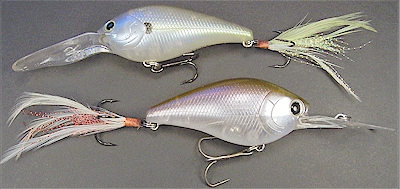 Lucky
Craft offers no less than 26 lipped cranks to North American
anglers. Lucky
Craft offers no less than 26 lipped cranks to North American
anglers.
The two I use most often are the CB350 (top in photo) and Flat
CB DR (bottom). Both these baits will get into the 8-10 foot
range. Most guys I see never or rarely use such deep
divers. One of the most productive places for these deep
divers are the tire reefs, other barrier reefs, and floating
breakwaters anchored around the perimeters of boat marinas to
break the force of wind-driven waves. These man-made reefs and
barriers make a safe harbor within the marinas, and they are also
bass magnets at times. These types of floating bass cover tend to
be out in open water, with little shade. In clear water, bass
tend to suspend deeper under the floating breakwaters where depth
equates to shade. These suspended bass are deeper than the
average crankbait can reach them, but not so deep that a
crankbait swimming in the 8-10 foot range can't entice them.
But deep diving crankbaits can be used in shallow water too.
Many times I am bouncing, digging and rooting along the bottom in
water as shallow as a few feet, even with these 8-10 foot divers.
In fact, it is commonplace around ledges, bars and depth breaks
to not get many hits while the crank is in deeper open water.
Strikes rarely come until the deep diver gets up on the nearby
shallow bar or ledge and starts stuttering across the gravel or
digging in the sand. At that point, bass will materialize out of
deep water, swimming onto the bar or ledge to pluck the
bottom-gouging crankbait off the shallow bottom, often only a few
feet deep.
|
|
| Lucky Craft
Moonsault CB350 Crankbait |
| CB350. Suspending. 2-1/2" (excluding lip). 1/2
oz. |
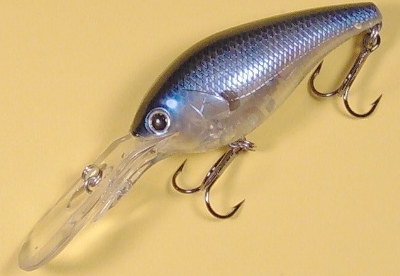 The
CB350 combines all the best features of fat-bodied crankbaits,
rattling vibration baits, and suspending jerkbaits into one lure.
It has the long bill, fat body, and deep-diving qualities of a
crankbait. Inside, it has seven rattling chambers
and a center wall that reverberates its rattles loudly!
Plus it's got a better internal suspension system than most
jerkbaits. Weights shift position so it casts far and dives
quickly, seeking bottom like most crankbaits. The
CB350 combines all the best features of fat-bodied crankbaits,
rattling vibration baits, and suspending jerkbaits into one lure.
It has the long bill, fat body, and deep-diving qualities of a
crankbait. Inside, it has seven rattling chambers
and a center wall that reverberates its rattles loudly!
Plus it's got a better internal suspension system than most
jerkbaits. Weights shift position so it casts far and dives
quickly, seeking bottom like most crankbaits.
It's best when it gets to bottom about 8 to 10 feet down. Once
there, it fishes most effectively when you use it as a
bottom-suspending jerkbait. It suspends and rises lazily when you
pause the retrieve. Pause to let it rise a little, then sweep and
twitch or jerk it to activate the rattles and cause erratic
quick-wiggling motion until it digs or bounces bottom again.
Then pause and hold on! You don't necessarily need to hit bottom
again - although that's always a helpful strike-triggering
option. Just sweep and twitch it like a dying shad and reel
slowly. The CB350 has a fast but tight wiggle even at a slow pace
retrieve. The supple swimming movement can be enhanced by
adding a long, thin feather tail. |
| Lucky Craft
Classical Leader 55SR and 55DR Crankbaits |
| Floating. 2-1/4" (excluding lip). Weight: 1/3 oz. |
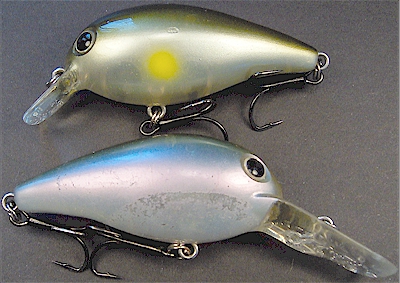 Over
five years ago, I had been given several Classical Leaders by
Lucky Craft employees visiting the USA from Japan. In comparison
to other high-tech, highly-detailed and glamorous Lucky Craft
lures, the Classical Leader has a much more simple construction
and plebian appearance. But its ordinary looks are deceptive.
Testing immediately revealed that the Classical Leader has one of
the best and most natural swimming motions of all Lucky Craft
lures. Over
five years ago, I had been given several Classical Leaders by
Lucky Craft employees visiting the USA from Japan. In comparison
to other high-tech, highly-detailed and glamorous Lucky Craft
lures, the Classical Leader has a much more simple construction
and plebian appearance. But its ordinary looks are deceptive.
Testing immediately revealed that the Classical Leader has one of
the best and most natural swimming motions of all Lucky Craft
lures.
One of the principals of Lucky Craft confirmed what I felt. He
confided in me that the Classical Leader was his personal
favorite fish-catcher among all Lucky Craft lures - but that it
was built and looked way too ordinary. Nevertheless, I have
caught countless bass on the Classical Leader. It's truly a great
bait. One of the best made by Lucky Craft - and also the most
ordinary lure they offer.
The DR (Deep Runner) maxes out around 6-7 feet with 10 lb.
test line. The SR (Shallow Runner)
It's common for many Japanese brand hardbaits to come with
hooks smaller than customary to North American anglers. We tend
to use heavier tackle and prefer larger hooks than our Japanese
counterparts. Some of the newer hardbait models that Lucky Craft
has developed just the last few years for the North American
market, the hooks tend to be sized properly. Yet on the legacy
lures originally developed for the Japanese market (like the
Classical Leader), the factory hooks routinely need to be upsized
by a North American angler.
I routinely replace both trebles on the Classical Leader with
#6 EWG trebles
Even with the many great new models of lures introduced by
Lucky Craft over the past five years, the old-fashioned Classical
Leader remains one of the most productive of all Lucky Craft
baits for me. Unfortunately there are only a few meager color
choices offered in the USA so far.
The Classical Leader swims like a charm and catches bass like
a champ. Fish just don't seem to notice it's not high-tech,
highly-detailed nor hardly as glamorous as other Lucky Crafts. |
| Lucky Craft Bevy
Crank 45SR and 45DR Crankbaits |
| Bevy Crank. Floating. 1-3/4" (excluding lip).
3/16 oz. |
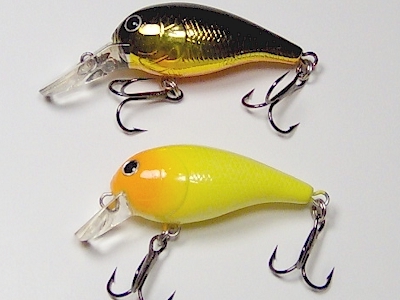 Japan's
anglers tend to use lighter tackle and smaller lures than their
North American counterparts. The compact Bevy Crank series by
Lucky Craft has been painstakingly designed and tested to excel
in the demanding light tackle market of Japan. Japan's
anglers tend to use lighter tackle and smaller lures than their
North American counterparts. The compact Bevy Crank series by
Lucky Craft has been painstakingly designed and tested to excel
in the demanding light tackle market of Japan.
The Bevy Crank has a weight-shifting system that gives this
lure great action and surprising casting distance on 4 to 8 lb.
test spinning gear.
Not only ideal for small stream and pond bass, the Bevy Crank
is ideal for trout, crappie, bluegill, perch and other
smaller-sized gamefish.
It's not clear whether these will remain around for long. They
were on Lucky Craft's discontinued list in 2004. |
| Lucky Craft
CB-Mighty D2RCrankbait |
| CB-Mighty. Floating. 1-3/4" (excluding lip). 1/4
oz. Lucky Craft USA has discontinued
this lure. |
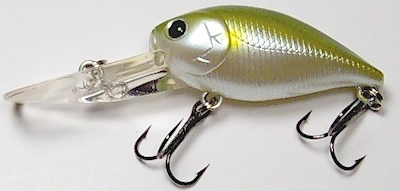 Under
2 inches long, the CB-Mighty was one of the smallest Lucky Craft
lipped crankbaits. Unfortunately, the CB-Mighty may not have sold
well in North America since Lucky Craft has taken it off the
market. Nevertheless, it is a great bait. It catches lots of bass
especially when larger crankbaits aren't working well. Under
2 inches long, the CB-Mighty was one of the smallest Lucky Craft
lipped crankbaits. Unfortunately, the CB-Mighty may not have sold
well in North America since Lucky Craft has taken it off the
market. Nevertheless, it is a great bait. It catches lots of bass
especially when larger crankbaits aren't working well.
Despite its small size, it is compact and heavy enough to cast
well even with a baitcaster. There are few other crankbaits
so small that can be wielded on a baitcaster -and that dive so
deeply. I'd say the CB-Mighty easily gets down around 8 or 9 feet
with 10 lb. test line.
It is especially useful as a tournament pre-fishing tool and
as a quick limit-filler when you need to put five squeakers in
the tank.
The CB-Mighty will attract a tremendous amount of attention
when you just want to pre-fish or "test fish" an area.
I favor a small crankbait of this size to pre-fish. You'll just
get a lot of action. So I keep one CB-Mighty with the hook points
rolled in when I want to determine how many fish are present, but
not hook them. Rubbed down in MegaStrike fish attractant gel,
such a small profile crankbait truly flushes out a lot of
pre-fish. This allows me to easily see the most active
fish-holding locations as I crank down a long stretch of bank
during pre-fish. This helps identify the types of cover,
structure, spots, and sections of a bank being used by bass.
Even without rolling the hook points inward, the stock hooks
are so small that a high percentage of fish will tend to bounce
off or let go of this bait without getting stuck. So when I want
to actually catch a few, I upgrade the rear treble hook one size
larger which helps grab a lot of fish that may miss the original
factory-rigged #8 treble hook. I don't change out the belly hook,
but I upgrade the tail treble to a #6 EWG style treble. You'll
immediately notice many more fish stay stuck and get landed with
the larger tail hook - and it doesn't detract from the lure's
action. |
| Lucky Craft Flat
CB MR Crankbait |
| Flat CB MR. Floating. 2-1/2" (excluding lip). 3/8
oz. |
Some years ago when Lucky Craft was first entering the North
American market, I had the opportunity to meet with and test some
of their crankbaits with one of their top lure designers at that
time. In terms of their crankbaits that had been successful in
Japan and that they hoped to introduce into North America, I
advised the hooks were too small and the balance too
temperamental for the North American market. By temperamental, I
mean they would work well on a slow retrieve, but on a moderate
to fast retrieve, became unbalanced and prone to go into a roll
as the balance weights shifted inside. A difference exists
between Japanese anglers who tend to use lighter tackle, smaller
hooks and nurture more delicate balance in lures versus North
American anglers who use heavier tackle, prefer larger hooks and
desire more lure stability than our Japanese counterparts.
Within a few years, Lucky Craft did indeed debut what they
then called their "Pro Tune Series" crankbaits
including the Flat CB MR, DR, D12 and D20. The new Pro Tune
series sported bigger hooks and more stable cranking actions.
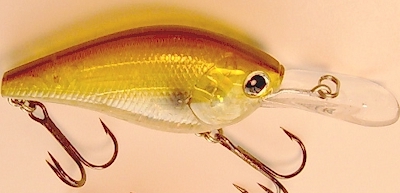 Flat
CB MR (Medium Runner). I'd say it works down around 5 feet
more or less with 10 lb. test line, and can be used with 12 to 14
lb. test line, not getting quite as deep. Flat
CB MR (Medium Runner). I'd say it works down around 5 feet
more or less with 10 lb. test line, and can be used with 12 to 14
lb. test line, not getting quite as deep.
One of my favorite modifications with this lure is to replace
the tail treble with a feathered one. I believe the feather
enhances the movement and appearance of this bait. That's not the
blanket case with all crankbaits, but it is one of the upgrades I
routinely perform with the Flat CB MR. On the Aurora Ghost Golden
Shiner color you see here, I often use an orange/copper feathered
hook. To me, this overall pattern represents a crawfish or a
sunfish. Of course, a white, white/chartreuse or whatever feather
works fine too.
I tend to use the Flat CB MR a lot like I use a lipless
rattling crankbait. It is stable and easy to crank at moderate to
fast paces. Similar to a lipless rattling crankbait, the Flat CB
MR has a flat-sided body and a tight fast wriggle. The advantage
is in snaggy areas, the Flat CB MR is not prone to get stuck as
easily as a lipless rattling crankbait. So I often go to the Flat
CB MR whenever fish are whacking lipless crankbaits in shallow or
flooded brush or snaggy areas. It's great to slam it through
shallow armchair-sized boulder beds too. These are places that
lipless rattlebaits get snagged fairly easily - but the Flat CB
MR with a similar action to rattlebaits does not get snagged as
much or as badly. |
| Lucky Craft Flat
CB DR Crankbait |
| Flat CB DR. Floating. 2-1/2" (excluding lip). 1/2
oz. |
 The
Flat CB DR is a money bait. I know of a number of tournaments won
with the help of the Flat CB DR. The
Flat CB DR is a money bait. I know of a number of tournaments won
with the help of the Flat CB DR.
The DR designation stands for Deep Runner. It works down
around 10 feet with 10 lb test, and slightly less with 12 lb
test.
At times I replace the tail treble on the Flat CB DR with a
feathered one, but it's hardly necessary to do this. A
white/chartreuse feather complements both the chartreuse shad and
the blue chartreuse color pattern you see here.
One thing to watch for in the Flat CB DR, D12 AND D20 is to
give them all a yank before cranking. Internally they have a
large metal ball that moves in a chamber to the back of the bait
to help maximize casting distance. The ball does not always
automatically roll back down the chamber behind the diving bill
at the completion of a cast. So you may need to yank them first
to help roll the ball down into the diving position before
cranking. |
| Lucky Craft Flat
CB D12 Crankbait |
| Flat CB D-12. Floating. 3" (excluding lip). 3/4
oz. |
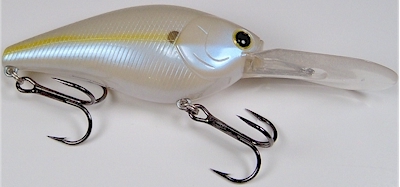 True
to its name, the D-12 does get down toward the 12 foot depth
range more or less. It is a heavy duty crankbait that's larger
and gets deeper than the crankbaits most anglers typically use -
and it dredges up larger bass than most anglers typically catch
as well. It's hard work to throw all day, but you can be
well-rewarded by the D-12. You may not get as many, but they'll
be heavy. True
to its name, the D-12 does get down toward the 12 foot depth
range more or less. It is a heavy duty crankbait that's larger
and gets deeper than the crankbaits most anglers typically use -
and it dredges up larger bass than most anglers typically catch
as well. It's hard work to throw all day, but you can be
well-rewarded by the D-12. You may not get as many, but they'll
be heavy.
|
| Lucky Craft Flat
CB D20 Crankbait |
| Flat CB D-20. Floating. 3" (excluding lip). 3/4
oz. |
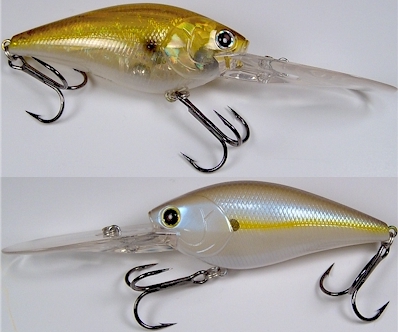 There
are only a few crankbaits that can get deeper than 15 feet
(without trolling) and handle well at that level. So when Lucky
Craft came out with the D20 approximately two years ago, it was
immediately deployed by some of the sport's top national and top
regional pro anglers. The pros who have been using these desire
to keep it quiet. It's much larger and dives deeper than most
anglers typically use. Indeed, it's about as extreme as a bass
crankbait gets to be. It's hard work to throw all day, but you
can be well-rewarded by large bass landed on the D20. There
are only a few crankbaits that can get deeper than 15 feet
(without trolling) and handle well at that level. So when Lucky
Craft came out with the D20 approximately two years ago, it was
immediately deployed by some of the sport's top national and top
regional pro anglers. The pros who have been using these desire
to keep it quiet. It's much larger and dives deeper than most
anglers typically use. Indeed, it's about as extreme as a bass
crankbait gets to be. It's hard work to throw all day, but you
can be well-rewarded by large bass landed on the D20.
|
| Lucky Craft
Lipless Rattlebaits |
|
 Lucky
Craft currently offers eight models of lipless rattlebaits. The
photo at right shows nine including (clockwise from top) the
finned LV70 (discontinued), LVR Mini (1/4 oz), LVR D7 (1/2 oz),
LVR D10 (3/4 oz), LVR D15 (1 oz), LV 500 (3/4 oz), LV200 (7/16
oz), LV300 (3/4 oz) and finned LV100 (7/16 oz). Lucky
Craft currently offers eight models of lipless rattlebaits. The
photo at right shows nine including (clockwise from top) the
finned LV70 (discontinued), LVR Mini (1/4 oz), LVR D7 (1/2 oz),
LVR D10 (3/4 oz), LVR D15 (1 oz), LV 500 (3/4 oz), LV200 (7/16
oz), LV300 (3/4 oz) and finned LV100 (7/16 oz).
The LV100 and LV500 were the first two introduced into the USA
approximately five years ago. The LV200 and LV300 were only
available in Japan (or on eBay) until mid-2004 when Lucky Craft
added them to their USA product line.
The LV100, 200, 300 and 500 sound as if they should be a
family or series of sizes of the same lure model. They're not. No
two LV models are even remotely related to each other. The LV100,
200, 300 and 500 are four totally different lures. All four are
designed differently and can do different things as described in
the following sections.
On the other hand, Lucky Craft's other four LVR models are a
related series - essentially the same lure design in four
different sizes. The four LVR's are relatively new designs
introduced a few years ago as part of what Lucky Craft at that
time called their "Pro Tune" series. The LVR D7 and D10
are the two I find most useful due to their average sizes. The
LVR Mini is a bit too light and the LVR D15 a bit too big for
everyday usage. But the LVR D7 and D10 are just right! Get more
info in the sections below. |
|
| Lucky Craft LV100
Rattlebait |
| LV100. 2-1/2". 7/16 oz. |
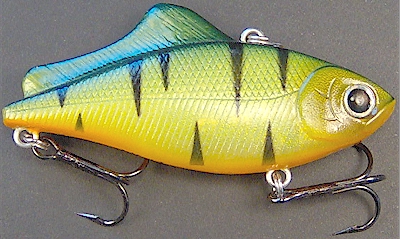 The
LV100 is a smaller lure; a great size for spinning tackle. I tend
to use the LV100 as a free-falling drop bait, a technique that's
also suited to spinning gear. The
LV100 is a smaller lure; a great size for spinning tackle. I tend
to use the LV100 as a free-falling drop bait, a technique that's
also suited to spinning gear.
Its small size, light weight, plus unique ability to fall
horizontally as it quivers makes the LV100 the finesse model. One
of the LV100's strengths is its slow yet perfect horizontal
falling quiver. Cast it beyond visible cover, retrieve it up to
the cover, and then pause for the LV100 to shiver and quiver down
alongside the cover. Fish barrel out of cover to blast it on the
fall.
Around ledges, depth breaks, dock pilings, marina walls,
simply drop it above the spot where fish are holding on the
ledge, on the wall, etc. When the LV100 sinks down to where the
fish are, it will always drops horizontally and slowly like a
natural fish. Twitch the line slightly once or twice every few
seconds as it falls. This activates a side-to-side quiver in the
falling lure. The LV100 hovers, quivers and falls slowly like a
flickering, injured baitfish. When it sinks to the depth where
fish are holding (or just above bottom), raise the rod tip to
vibrate and rattle the LV100 a few feet upward, then let it
quiver and shiver back toward the fish again. Repeat this yo-yo
motion of a struggling baitfish until you trigger a bite. |
| Lucky Craft LV200
Rattlebait |
| LV200. 5/8 oz. |
 Whereas
the LV100 has four internal weight chambers for several sizes of
brass, glass and steel BBs, the LV200 has only one single large
ball affixed to a loose plate inside. The LV200 emits a
single-thump heartbeat as opposed to the incessant, raucous
chatter of "normal" rattlebaits. Whereas
the LV100 has four internal weight chambers for several sizes of
brass, glass and steel BBs, the LV200 has only one single large
ball affixed to a loose plate inside. The LV200 emits a
single-thump heartbeat as opposed to the incessant, raucous
chatter of "normal" rattlebaits.
|
| Lucky Craft LV300
Rattlebait |
| LV300. 3/4 oz. |
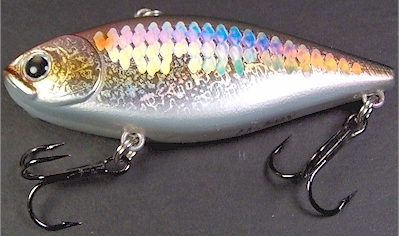 As
odd as it is for the LV200 to contain only one ball to make it
thump like a lonesome drum, the LV300 has absolutely zero rattles
inside. The LV300 is like Charlie Chan, the silent movie star of
the thirties... but that's not bad. As
odd as it is for the LV200 to contain only one ball to make it
thump like a lonesome drum, the LV300 has absolutely zero rattles
inside. The LV300 is like Charlie Chan, the silent movie star of
the thirties... but that's not bad.
Both these quieter rattlebaits, the LV200 and 300 have helped
me catch buckets of "extra" rattlebait bass. How I use
the LV200 and 300 is to first go down a bank and pull the initial
receptive fish with a "normal" high-chattering
rattlebait such as a Bill Lewis Rat-L-Trap or a Daiwa TD
Vibration. This noisiness "wakes up the bass" so to
speak. Once fish are exposed to fan-casting with high-chatterers,
it can quickly become counterproductive to go back down the same
bank again with the same high-chattering baits. The repeated
noisiness (an attractant at first), can become a repellant that
only serves to alienate fish(or so it seems) by continuing to
throw the very loud, harsh rattlebaits. So what I do instead is
go down the same bank again with the silent LV300 or
single-thumping LV200, often helping myself to catch another few
good fish with this quieter approach the second time. It's a
similar profile, similar vibration without the high-chatter. A
few more fish always seem to fall for it.
Except for the LV200 and LV300, there are few other quiet-type
rattlebaits that perform so well for me. |
| Lucky Craft LV500
Rattlebait |
| LV500. 3". 3/4 oz. |
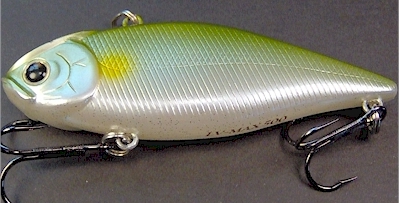 The
body size of the LV500 matches that of most other 1/2 oz
rattlebaits. However, the LV500 is 3/4 oz so it casts longer
distance and it descends much deeper than the others. This is the
reason I rely on the LV500 - it covers more distance much deeper
than most any other rattlebait. The
body size of the LV500 matches that of most other 1/2 oz
rattlebaits. However, the LV500 is 3/4 oz so it casts longer
distance and it descends much deeper than the others. This is the
reason I rely on the LV500 - it covers more distance much deeper
than most any other rattlebait.
When you cast, you must begin the retrieve immediately with
the LV500. If you wait to let the LV500 settle deeper, it tends
to twirl around and snarl the fishing line in the hooks if you
let it drop or if you pause to yo-yo it.
So, just burn it back! The LV500 casts further and covers more
water than other rattlebaits. It will seek a working level of 7
to 10 feet deep all by itself. This is below where most other
rattlebaits will stay on a retrieve. Best of all, you can burn
the LV500, and it will still stay deep.
A favorite LV500 application for me is to burn deep points. In
lakes with lots of points, this can become an LV500 pattern many
days, where a bass or two will belt the LV500 (usually retrieved
fast) on practically every point. Once you uncover a pattern and
it seems repeatable on a few points, then you can run from point
to point to point, and repeatedly present the LV500 the same way
each time - and pull a bass or two off each point. In this way,
the LV500 functions as a highly productive pattern bait - not
just for points, but for whatever other repeatable pattern you
can produce with the LV500. Keep in mind, it is the deepest
runner, but you cannot count it down or pause it without
frequently snarling the line.
The color shown here, Pearl Ayu excels in all water
color from clear to dark. The shiny pearl sides emit a bright
white flash. |
| Lucky Craft LVR D7
Rattlebait |
| LVR D7. 2-1/4" 1/2 oz. |
 The
design of the LVR D7 is thinner and to me, the LVR D7 tends to
ride higher with a little less vibration and less chatter than
usual. I'm not saying it doesn't chatter a lot, but it is less
loud. It's most useful for me in shallow situations, when I want
to keep a rattlebait high, or where I want to rattle through
snaggy cover that grabs and holds other rattlebaits way too
often, the LVR D7 gets the nod. The
design of the LVR D7 is thinner and to me, the LVR D7 tends to
ride higher with a little less vibration and less chatter than
usual. I'm not saying it doesn't chatter a lot, but it is less
loud. It's most useful for me in shallow situations, when I want
to keep a rattlebait high, or where I want to rattle through
snaggy cover that grabs and holds other rattlebaits way too
often, the LVR D7 gets the nod.
The color shown ais Aurora Ghost Golden Shiner. This is
one of my pet Lucky Craft colors. So far, it has been a limited
color that does not come in many models. The color can resemble a
greenish/brownish crawdad. I often add an orange/copper feather
treble to enhance this color pattern. With the orange tail, it
can resemble a green sunfish as much as a crawfish. |
| Lucky Craft LVR
D10 Rattlebait |
| LVR D10. 3-1/4". 3/4 oz. |
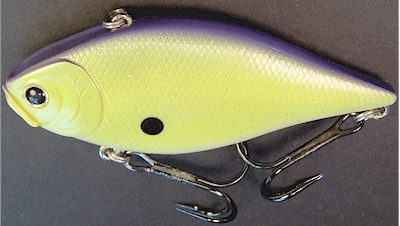 The
LVR D10 has a bigger profile than most rattlebaits. That's the
simple reason I use it - to appeal to bigger bass. If you throw
the LVR D10 all day, you will have a bigger average size of bass
than if you threw standard size rattlebaits in the same places.
It's that simple. The
LVR D10 has a bigger profile than most rattlebaits. That's the
simple reason I use it - to appeal to bigger bass. If you throw
the LVR D10 all day, you will have a bigger average size of bass
than if you threw standard size rattlebaits in the same places.
It's that simple.
The LVR D10 has #4 trebles. I replace these with a pair of #2
trebles. The LVR D7, LV500, LV300, LV200 all get upgraded to a
pair of #4 trebles. |
 I
like red trebles on rattlebaits. On the LVR D7 (top in photo) and
the LV200 (bottom), I hang feathered trebles off the back. I find
feathers enhance the day-to-day action and appearance of those
two models - but feathers do not necessarily add anything
spectacular to the other LV or LVR models. I like three feathers
and a little flash tied into it. I
like red trebles on rattlebaits. On the LVR D7 (top in photo) and
the LV200 (bottom), I hang feathered trebles off the back. I find
feathers enhance the day-to-day action and appearance of those
two models - but feathers do not necessarily add anything
spectacular to the other LV or LVR models. I like three feathers
and a little flash tied into it.
Fish tend to strike directly at the feathers - or engulf the
lure from behind. This contradicts a popular strike theory that
says fish bite at the back of a crankbait, jerkbait or rattlebait
to indicate to the angler that these fish aren't overly-impressed
with the lure, and the back bites are to tell the angler to toss
them a better color than this bogus one. According to this
theory, fish strike at the back hook of a bait because it's the
wrong color, wrong size or the baits holding its mouth wrong.
This theory is not true - at least not with feathered tails. Fish
strike the feathered back hook because they like it, because
that's where the action is. |
|
